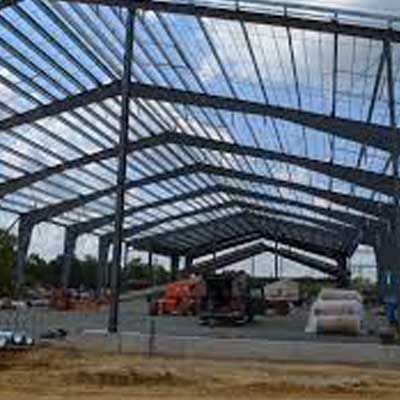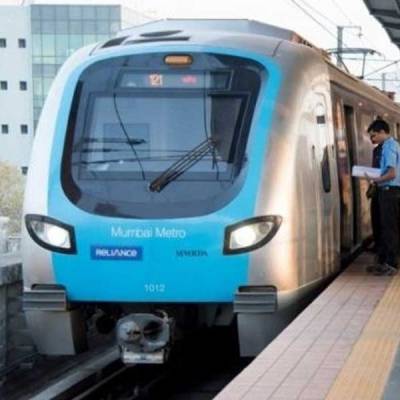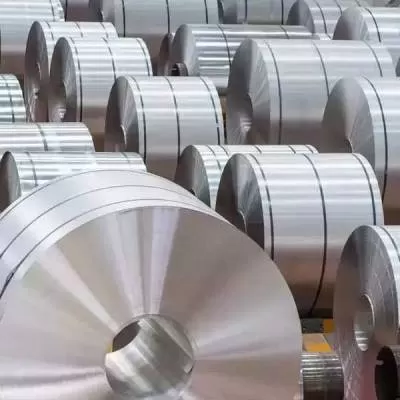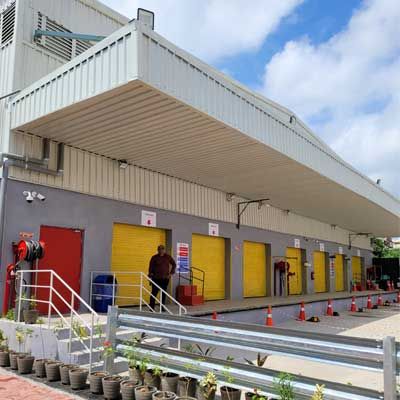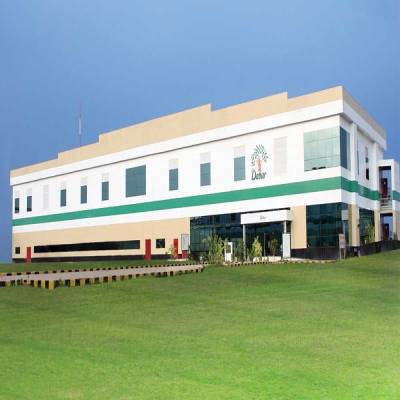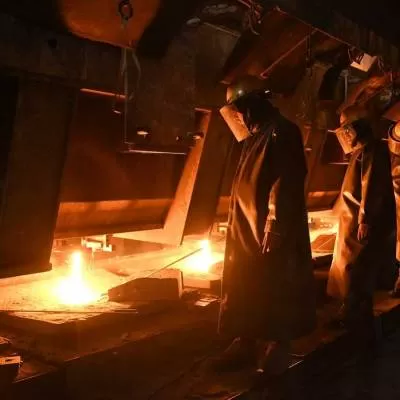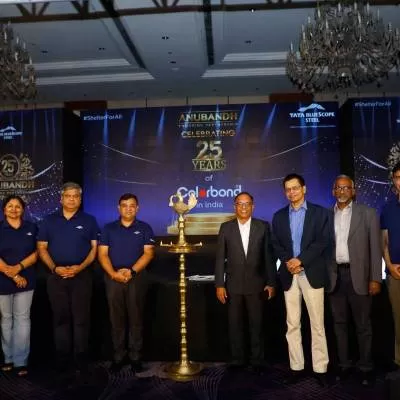- Home
- Building Material
- Steel
- Built to Suit

Built to Suit
A33-storey tower built in 99 days; a two-storey facility in 75 days; a 60-m-long metro bridge in less than a week - India is setting records, and how! In the past decade, the country has seen a burst of infrastructure activities, the need being light structures that are quick to erect. Testament to this is Bhasin Group, who is building a 33-storey tower in 99 days. SS Bhasin, Managing Director, shares: ¨We knew that a pre-engineered building (PEB) steel structure would be easy to get and install. By reducing timelines, we plan to save about two years of delay in delivering the project.¨ In another move, Everest Industries is currently constructing HCL IT city - developing two buildings measuring over 200,000 sq ft in less than six months. Here, much of the work is done using over 3,000 mt of steel beams and columns.
¨PEB is fast to fabricate, transport and erect on site in any configuration, including large span, multi-levels, light and heavy loads as well as shapes of roof, as per the design,¨ shares architect CN Raghavendran, Managing Director, CR Narayana Rao (Consultants) Pvt Ltd.
Market outlook
India is the third largest PEB market in the world after the US and China. ¨Its market size is about 0.5 million metric tonne, with a growth rate of 8-10 per cent,¨ shares D Raju, Managing Director, Kirby Building Systems India Pvt Ltd. But, for Alakesh Roy, Managing Director, Zamil Steel, India, the PEB market in the past year has been flat. However, he believes that with the recent Make in India initiative, there is now an upbeat sentiment and things are positive. ¨It can speed up construction in infrastructure projects,¨ he avers.
Industrial and warehousing sectors are converting to PEB, as always. Raju adds, ¨In warehousing, over 100 million sq ft of space is being added every year.¨ Prefab in roofing is gaining ground, and the impetus on agriculture in the current Budget will drive demand for quality roofing from the rural sector. ¨The PEB market should grow at 10-12 per cent this fiscal too,¨ says Manish Garg, President & Chief Executive-Steel Building Business, Everest Industries Ltd.
At present, the growth areas are commercial, housing, infrastructure, industrial, buildings, stadiums, metro projects, etc. Raju says, ¨High rises are expected to create strong demand in the next five years.¨
¨Meanwhile, in Tier-II and Tier-III cities, too, we see some traction,¨ adds Gautam Suri, CTO and Founder Director, Interarch Building Products Pvt Ltd. ¨Corporate entities are also increasingly opting for PEB structures in the recent past.¨
Timely solution
As timely construction is crucial, PEB seems to be the ideal choice. Suri lists the advantages: ¨Early occupancy and return on investment mainly owing to reduced construction time by 30-40 per cent; possibilities of large, clear span structures up to 100 m and height of up to 30 m are possible; and mezzanine floors can be constructed, which help in maximum usage of space and, hence, provide better utilisation of money spent every square feet.¨ Also, steel structures are cost-effective compared to conventional construction. ¨Falling steel prices are a positive sign for companies like ours,¨ adds Suri.
Efficient to produce and quick to construct, PEB offers good architectural design, which is achievable at low cost, and speed in construction.
Raghavendran adds, ¨The PEB erection process is easy and, further, PEBs are flexible and can be expanded in the future if needed.¨ Besides, prefab works are done inside factories; at site, only bolt and nuts are used for erection, without causing air pollution. ¨PEB structures can be custom-fabricated according to the stress that the building will experience and, therefore, are effective.¨
Time and speed help save costs on structures including roofing. ¨Compared to conventional methods, PEB roofing can reduce time by more than half and eliminate delays of unavailability of skilled manpower,¨ says Bhasin.
Roofing trends
India´s roofing industry has been traditionally dominated by galvanised steel sheets. ¨For roofing, galvalume sheets are used, the advantages being corrosion-resistance and a warranty of 10-15 years,¨ shares Roy. While he exclaims every square feet of a structure requires roofing, Garg agrees that PEB would predominantly use metal roofing.
One important element in roofing systems is the ability to reduce thermal heat gain, especially in hot weather. Raghavendran explains, ¨The higher the solar reflectivity index, the more heat reflected, which is better to reduce heat transmission.¨ Also, recyclability and life-cycle costs are high. New trends, according to him, are seen in the structural capability of roofing materials, in terms of span-to-weight ratio going up with the introduction of high-strength materials, special interlocking ways, reducing the number of joints and overlaps, etc.
Also, new trends are seen in coloured fibre cement sheets, coloured metal sheets and, to some extent, poly-coloured sheets, explains Garg, as these are ligh-weight and don´t corrode over a period of exposure.
Cost-effective
A recyclable material, a steel-based structure is in itself green. In fact, the raw material used in PEB itself has a high recycle content, required for green construction. ¨Moreover, steel when sold as scrap, results in high resale value,¨ shares Raju. And Suri adds, ¨PEB structures are energy-efficient, which results in reduced electricity bills.¨
Moreover, considering the complete life-cycle, PEB is more economical than an RCC building. Longevity of steel roofs is high and they are not prone to leakages. With PEB roof cost being about Rs 400-450 per sq ft, conventional roofs may cost less, ¨but on a lifecycle basis, PEB roofs are cheaper,¨ informs Roy.
For Garg, PEB roofs are 20 per cent more economical than any other form. He further explains, ¨An industrial building with conventional methods would cost about Rs 600-700 per sq ft, whereas PEB will be about Rs 550-600 per sq ft.¨
PEBs are fire and earthquake-resistant with low or negligible maintenance cost, which again saves on the overall building cost and cheaper belowground owing to lighter foundations, shares Suri.
While Bhasin Group has not arrived at the net savings for its Noida project yet, the company hopes to reduce the per-square-feet cost by about 12.5-15 per cent.
Application offerings Vendors are upbeat!
Kirby India offers Kirby Standing Seam Panel systems (KSS-600), which is 100 per cent leak proof, with excellent protection in all weather conditions.
It provides two other roofing systems with a depth of 28 mm and 32 mm each, respectively. The company caters to metro stations, shipyards, power plants, high-rise buildings, etc.
Everest Industries offers fibre
cement roofing, metal roofing, polycarbonate roofing, etc. The usage for fibre cement roofing is primarily in rural, in residential and retail, whereas metal is preferred in hilly terrains, in industrial and infra urbanised projects. Coloured fibre cement roofs and Everest durasteel and primsteel metal roofs offer value for money.
While Zamil Steel India´s product range includes pre-engineered buildings, structural steel buildings, roof and wall panels, among others; Interarch Building Products, too, offer pre-engineered metal building systems, TRACDEK® metal roof and wall systems, and light building systems, among others.
Rebuilding solution
Steel structure is the best non-conventional method to use in seismic zones; these are light and designed as per the specific elements required.
¨We delivered a project for Amarpali Banquet Hall in Nepal prior to the earthquake, and after the quake, it became a place where people came for refuge and stayed,¨ shares Suri. Adding on why prefab structures help in rebuilding disaster-prone cities, Roy says, ¨Facilities within the city are not required to rebuild the structure.¨ Other than seismic zones, PEB structures can also take the impact of floods as witnessed in Chennai and Uttarakhand.
New dawn in some segments
The PEB sector has been growing with increasing awareness. And, with the projected growth in the Indian economy and upgrade of existing cities and smart cities, these structures will gain popularity.
The food and paper industry are segments, among others, where prefab structures are gaining popularity, unlike earlier, shares Roy. Garg mentions ¨railway workshops, townships, malls, IT buildings, and shopping malls¨ as new additions.
PEB buildings have been recently used as multilevel car parking structures. For Raghavendran, ¨In due course, steel buildings that are fire-resistant and thermal-efficient such as roof and cladding will become common.¨
Developers such as Bhasin have chosen PEB as their way forward: ¨We find PEB structures easy to construct and deliver in lesser time and at low cost, with savings on early completion.¨ However, he believes that the trend needs to be encouraged by stringent building code rules.
Looking ahead
With a promising future, challenges still plague the PEB industry: Price volatility of steel, drop in new investments, high tax structure and application anomalies. As Roy says, ¨When steel prices drop, people tend to hold back their investments.¨ Hence, the oversupply.
Further, engineers use varied norms for PEB buildings. To this, Bhasin adds: ¨We need to develop a standard code. Vendors can play an important role by reducing cost as well as the overall weight of the structure. With not many reputed PEB vendors, monopoly has come to play, which needs to be eliminated.¨
But Raghavendran sees the positives: There are no major challenges as the Indian code, which was once not elaborate - now covers PEB structures.¨ A good sign indeed!
- India enjoys third largest PEB market space in the world; expected growth, 10-12% this fiscal.
- Growth areas: Commercial, housing, infrastructure, industrial, buildings, stadiums, metro projects, high-rises, etc.
- PEB roofs are 20% more economical than any other form
CASE STUDY: ROOFING
JSW Steel´s re-roofing project was a challenging one that Tata Bluescope Steel Ltd (TBSL) took upon as an opportunity.
Project: JSW Steel.
Location: Bellary, Karnataka.
Building usage: Cold Roll Mill (CRM).
Scope of work: Retrofitting solution on roof above roof. Supply and installation of LYSAGHT KLIPLOK®700 Roofing profile in running plant to provide a 100-per-cent leak-proof solution.
Solution: Double framing and roofing with LYSAGHT KLIPLOK® 700
Area of roof covered: 14,500 sq m
Key differentiators: 100-per-cent leak-proof solution and express delivery in spite of all odds.
Background: JSW Steel´s largest CRM mill required urgent re-roofing as it was facing an acute problem of water ingress through crevices on existing roofs. In a highly critical environment, where unceasing cold and hot rolled coils are manufactured, stopping the plant would have incurred tremendous losses owing to capacity wastage. It was imperative for JSW Steel to have an expert who would provide a solution without hindering its ongoing business.
Challenges vs. Solutions
Challenge: Uneven undulations in roof
Solution: Welding of purlin cleats on existing rafters
To correct the undulations, specially designed cleats of 0.535 m were used. These cleats were then welded on the existing rafters. Welding sparks were addressed by using asbestos cloth. Welding of 0.2-m L angles with 0.535-m purlin cleat was done to align the rafter undulation and maintain purlin level.
Challenge: Roof leakage
Solution: Conceal fixed LYSAGHT KLIP-LOK®700 profile was supplied and installed with a single length of 19 m from ridge to eve to provide 100-per-cent leak-proof solution. Onsite roll forming solution addressed the challenge of long length of 19 m. Quality workmanship has ensured the lifting of long length sheet to 33 m height and meticulous installation to meet the leak-proof objective.
Challenge: Safety
Solution: Safety net was harnessed during running plant to avoid the fall. CO monitor was placed on the roofing area to check CO leakage, in the event of which, workers were not allowed to work on the roof.
Challenge: On-time project completion
Solution: The project was completed in time by making express delivery, sheet installation by skilled manpower and extra efforts by TBSL team to complete the entire project in time.
Conclusion: TBSL´s LYSAGHT KLIP LOK® 700 profile was a perfect roofing solution, coupled with TBSL´s excellent project management capabilities. Hundred-per-cent leak-proof re-roofing with express delivery was the key differentiator that ensured customer delight; this project was a huge success and was applauded by the client.
Client testimony: ¨The supply and installation job, including the design and engineering awarded to TBSL, has been executed successfully to our satisfaction,¨ affirms VVLB Rao, Head of Department, CRM-I, JSW Steel. ¨We appreciate the efforts made by the TBSL construction team in meeting our quality and safety expectations during site execution activity.¨
To share your views on the PEB, Prefab and Roofing market in India, write in at feedback@ConstructionWorld.in
- PEB
- Bhasin Group
- SS Bhasin
- HCL
- CN Raghavendran
- CR Narayana Rao (Consultants) Pvt Ltd
- D Raju
- Kirby Building Systems India Pvt Ltd
- Alakesh Roy
- Zamil Steel
- Manish Garg
- Everest Industries Ltd
- Gautam Suri
- Interarch Building Products Pvt Ltd
- RCC Building
- Kirby Standing Seam
- Everest Industries
- JSW Steel
- Tata Bluescope Steel Ltd
- Cold Roll Mill
Being a cost-effective and timely solution, PEB is gaining popularity, with immense opportunities on the anvil. A33-storey tower built in 99 days; a two-storey facility in 75 days; a 60-m-long metro bridge in less than a week - India is setting records, and how! In the past decade, the country has seen a burst of infrastructure activities, the need being light structures that are quick to erect. Testament to this is Bhasin Group, who is building a 33-storey tower in 99 days. SS Bhasin, Managing Director, shares: ¨We knew that a pre-engineered building (PEB) steel structure would be easy to get and install. By reducing timelines, we plan to save about two years of delay in delivering the project.¨ In another move, Everest Industries is currently constructing HCL IT city - developing two buildings measuring over 200,000 sq ft in less than six months. Here, much of the work is done using over 3,000 mt of steel beams and columns. ¨PEB is fast to fabricate, transport and erect on site in any configuration, including large span, multi-levels, light and heavy loads as well as shapes of roof, as per the design,¨ shares architect CN Raghavendran, Managing Director, CR Narayana Rao (Consultants) Pvt Ltd. Market outlook India is the third largest PEB market in the world after the US and China. ¨Its market size is about 0.5 million metric tonne, with a growth rate of 8-10 per cent,¨ shares D Raju, Managing Director, Kirby Building Systems India Pvt Ltd. But, for Alakesh Roy, Managing Director, Zamil Steel, India, the PEB market in the past year has been flat. However, he believes that with the recent Make in India initiative, there is now an upbeat sentiment and things are positive. ¨It can speed up construction in infrastructure projects,¨ he avers. Industrial and warehousing sectors are converting to PEB, as always. Raju adds, ¨In warehousing, over 100 million sq ft of space is being added every year.¨ Prefab in roofing is gaining ground, and the impetus on agriculture in the current Budget will drive demand for quality roofing from the rural sector. ¨The PEB market should grow at 10-12 per cent this fiscal too,¨ says Manish Garg, President & Chief Executive-Steel Building Business, Everest Industries Ltd. At present, the growth areas are commercial, housing, infrastructure, industrial, buildings, stadiums, metro projects, etc. Raju says, ¨High rises are expected to create strong demand in the next five years.¨ ¨Meanwhile, in Tier-II and Tier-III cities, too, we see some traction,¨ adds Gautam Suri, CTO and Founder Director, Interarch Building Products Pvt Ltd. ¨Corporate entities are also increasingly opting for PEB structures in the recent past.¨ Timely solution As timely construction is crucial, PEB seems to be the ideal choice. Suri lists the advantages: ¨Early occupancy and return on investment mainly owing to reduced construction time by 30-40 per cent; possibilities of large, clear span structures up to 100 m and height of up to 30 m are possible; and mezzanine floors can be constructed, which help in maximum usage of space and, hence, provide better utilisation of money spent every square feet.¨ Also, steel structures are cost-effective compared to conventional construction. ¨Falling steel prices are a positive sign for companies like ours,¨ adds Suri. Efficient to produce and quick to construct, PEB offers good architectural design, which is achievable at low cost, and speed in construction. Raghavendran adds, ¨The PEB erection process is easy and, further, PEBs are flexible and can be expanded in the future if needed.¨ Besides, prefab works are done inside factories; at site, only bolt and nuts are used for erection, without causing air pollution. ¨PEB structures can be custom-fabricated according to the stress that the building will experience and, therefore, are effective.¨ Time and speed help save costs on structures including roofing. ¨Compared to conventional methods, PEB roofing can reduce time by more than half and eliminate delays of unavailability of skilled manpower,¨ says Bhasin. Roofing trends India´s roofing industry has been traditionally dominated by galvanised steel sheets. ¨For roofing, galvalume sheets are used, the advantages being corrosion-resistance and a warranty of 10-15 years,¨ shares Roy. While he exclaims every square feet of a structure requires roofing, Garg agrees that PEB would predominantly use metal roofing. One important element in roofing systems is the ability to reduce thermal heat gain, especially in hot weather. Raghavendran explains, ¨The higher the solar reflectivity index, the more heat reflected, which is better to reduce heat transmission.¨ Also, recyclability and life-cycle costs are high. New trends, according to him, are seen in the structural capability of roofing materials, in terms of span-to-weight ratio going up with the introduction of high-strength materials, special interlocking ways, reducing the number of joints and overlaps, etc. Also, new trends are seen in coloured fibre cement sheets, coloured metal sheets and, to some extent, poly-coloured sheets, explains Garg, as these are ligh-weight and don´t corrode over a period of exposure. Cost-effective A recyclable material, a steel-based structure is in itself green. In fact, the raw material used in PEB itself has a high recycle content, required for green construction. ¨Moreover, steel when sold as scrap, results in high resale value,¨ shares Raju. And Suri adds, ¨PEB structures are energy-efficient, which results in reduced electricity bills.¨ Moreover, considering the complete life-cycle, PEB is more economical than an RCC building. Longevity of steel roofs is high and they are not prone to leakages. With PEB roof cost being about Rs 400-450 per sq ft, conventional roofs may cost less, ¨but on a lifecycle basis, PEB roofs are cheaper,¨ informs Roy. For Garg, PEB roofs are 20 per cent more economical than any other form. He further explains, ¨An industrial building with conventional methods would cost about Rs 600-700 per sq ft, whereas PEB will be about Rs 550-600 per sq ft.¨ PEBs are fire and earthquake-resistant with low or negligible maintenance cost, which again saves on the overall building cost and cheaper belowground owing to lighter foundations, shares Suri. While Bhasin Group has not arrived at the net savings for its Noida project yet, the company hopes to reduce the per-square-feet cost by about 12.5-15 per cent. Application offerings Vendors are upbeat! Kirby India offers Kirby Standing Seam Panel systems (KSS-600), which is 100 per cent leak proof, with excellent protection in all weather conditions. It provides two other roofing systems with a depth of 28 mm and 32 mm each, respectively. The company caters to metro stations, shipyards, power plants, high-rise buildings, etc. Everest Industries offers fibre cement roofing, metal roofing, polycarbonate roofing, etc. The usage for fibre cement roofing is primarily in rural, in residential and retail, whereas metal is preferred in hilly terrains, in industrial and infra urbanised projects. Coloured fibre cement roofs and Everest durasteel and primsteel metal roofs offer value for money. While Zamil Steel India´s product range includes pre-engineered buildings, structural steel buildings, roof and wall panels, among others; Interarch Building Products, too, offer pre-engineered metal building systems, TRACDEK® metal roof and wall systems, and light building systems, among others. Rebuilding solution Steel structure is the best non-conventional method to use in seismic zones; these are light and designed as per the specific elements required. ¨We delivered a project for Amarpali Banquet Hall in Nepal prior to the earthquake, and after the quake, it became a place where people came for refuge and stayed,¨ shares Suri. Adding on why prefab structures help in rebuilding disaster-prone cities, Roy says, ¨Facilities within the city are not required to rebuild the structure.¨ Other than seismic zones, PEB structures can also take the impact of floods as witnessed in Chennai and Uttarakhand. New dawn in some segments The PEB sector has been growing with increasing awareness. And, with the projected growth in the Indian economy and upgrade of existing cities and smart cities, these structures will gain popularity. The food and paper industry are segments, among others, where prefab structures are gaining popularity, unlike earlier, shares Roy. Garg mentions ¨railway workshops, townships, malls, IT buildings, and shopping malls¨ as new additions. PEB buildings have been recently used as multilevel car parking structures. For Raghavendran, ¨In due course, steel buildings that are fire-resistant and thermal-efficient such as roof and cladding will become common.¨ Developers such as Bhasin have chosen PEB as their way forward: ¨We find PEB structures easy to construct and deliver in lesser time and at low cost, with savings on early completion.¨ However, he believes that the trend needs to be encouraged by stringent building code rules. Looking ahead With a promising future, challenges still plague the PEB industry: Price volatility of steel, drop in new investments, high tax structure and application anomalies. As Roy says, ¨When steel prices drop, people tend to hold back their investments.¨ Hence, the oversupply. Further, engineers use varied norms for PEB buildings. To this, Bhasin adds: ¨We need to develop a standard code. Vendors can play an important role by reducing cost as well as the overall weight of the structure. With not many reputed PEB vendors, monopoly has come to play, which needs to be eliminated.¨ But Raghavendran sees the positives: There are no major challenges as the Indian code, which was once not elaborate - now covers PEB structures.¨ A good sign indeed! India enjoys third largest PEB market space in the world; expected growth, 10-12% this fiscal. Growth areas: Commercial, housing, infrastructure, industrial, buildings, stadiums, metro projects, high-rises, etc. PEB roofs are 20% more economical than any other form CASE STUDY: ROOFING JSW Steel´s re-roofing project was a challenging one that Tata Bluescope Steel Ltd (TBSL) took upon as an opportunity. Project: JSW Steel. Location: Bellary, Karnataka. Building usage: Cold Roll Mill (CRM). Scope of work: Retrofitting solution on roof above roof. Supply and installation of LYSAGHT KLIPLOK®700 Roofing profile in running plant to provide a 100-per-cent leak-proof solution. Solution: Double framing and roofing with LYSAGHT KLIPLOK® 700 Area of roof covered: 14,500 sq m Key differentiators: 100-per-cent leak-proof solution and express delivery in spite of all odds. Background: JSW Steel´s largest CRM mill required urgent re-roofing as it was facing an acute problem of water ingress through crevices on existing roofs. In a highly critical environment, where unceasing cold and hot rolled coils are manufactured, stopping the plant would have incurred tremendous losses owing to capacity wastage. It was imperative for JSW Steel to have an expert who would provide a solution without hindering its ongoing business. Challenges vs. Solutions Challenge: Uneven undulations in roof Solution: Welding of purlin cleats on existing rafters To correct the undulations, specially designed cleats of 0.535 m were used. These cleats were then welded on the existing rafters. Welding sparks were addressed by using asbestos cloth. Welding of 0.2-m L angles with 0.535-m purlin cleat was done to align the rafter undulation and maintain purlin level. Challenge: Roof leakage Solution: Conceal fixed LYSAGHT KLIP-LOK®700 profile was supplied and installed with a single length of 19 m from ridge to eve to provide 100-per-cent leak-proof solution. Onsite roll forming solution addressed the challenge of long length of 19 m. Quality workmanship has ensured the lifting of long length sheet to 33 m height and meticulous installation to meet the leak-proof objective. Challenge: Safety Solution: Safety net was harnessed during running plant to avoid the fall. CO monitor was placed on the roofing area to check CO leakage, in the event of which, workers were not allowed to work on the roof. Challenge: On-time project completion Solution: The project was completed in time by making express delivery, sheet installation by skilled manpower and extra efforts by TBSL team to complete the entire project in time. Conclusion: TBSL´s LYSAGHT KLIP LOK® 700 profile was a perfect roofing solution, coupled with TBSL´s excellent project management capabilities. Hundred-per-cent leak-proof re-roofing with express delivery was the key differentiator that ensured customer delight; this project was a huge success and was applauded by the client. Client testimony: ¨The supply and installation job, including the design and engineering awarded to TBSL, has been executed successfully to our satisfaction,¨ affirms VVLB Rao, Head of Department, CRM-I, JSW Steel. ¨We appreciate the efforts made by the TBSL construction team in meeting our quality and safety expectations during site execution activity.¨ To share your views on the PEB, Prefab and Roofing market in India, write in at feedback@ConstructionWorld.in



